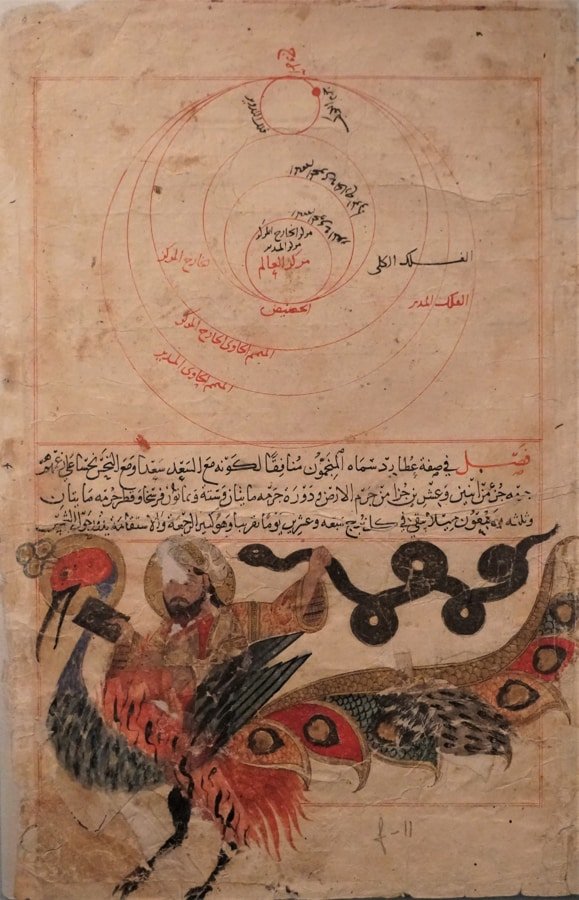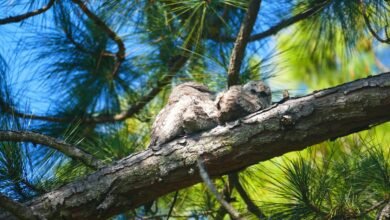The British Library, July 2022
‘The feeling of awed wonder that science can give us is one of the highest experiences of which the human psyche is capable. It is a deep aesthetic passion to rank with the finest that music and poetry can deliver.’ Richard Dawkins [i]
Zakriya ibn Muhammad al-Qazwini, The Wonders of Creation, (literally, ‘Marvels of things created and miraculous aspects of things existing, Persia, circa 1250. This copy produced in the Deccan, South India, 16th C, The British Library.
On the way to St Pancras to catch Eurostar, I stopped by the British Library. I love manuscript art, but had been avoiding London. Treasures of the British Library was a chance to see some art. Qazwini was a Persian cosmographer and geographer of Arab ancestry who used Greek and Roman astronomy to explain movement of Mercury, stars. Qazwini’s ‘The Wonders of Creation’ became immensely popular as an illustrated encyclopaedia and one of the best-known texts of the Islamic world, copied many times. It begins with the heavens, where a hierarchy of angels live. They maintain the running of the creation and govern everything on earth, except the jinn and devils, disobedient, bad-tempered creatures.
The second part describes the seas and their creatures, followed by descriptions of plants, animals, birds, and insects and finally a section on fantastic creatures. Qazwini mentions fifty names as his sources, the most important of whom are old geographers and historians. It was a good read. Scientific explanations were embellished with stories and poetry.
The Phoenix is a colourful, mythical, sacred firebird in Greek and Romans mythologies, possibly inspired by the Egyptian Bennu. At death, the Phoenix self-combusts and is reborn from the ashes. There is only ever one Phoenix alive at one time. Pliny the Elder states, ‘The story is that it is as large as an eagle, and has a gleam of gold round its neck and all the rest of it is purple, but the tail blue picked out with rose-coloured feathers and the throat picked out with tufts, and a feathered crest adorning its head.’ [ii] Early Christians used the Phoenix as an allegory and proof of Christ’s resurrection.
Qazwini argued that God created the birds because he knew that many people would be sceptical of the existence of flying creatures, especially angels.
Not that many are sceptical, even in the 21st century. Surveys in the USA by reputable research groups typically find that:
55 percent say they believe in angels.
39 percent say they accept the concept of evolution.
36 percent say they believe global warming is partly anthropogenic.
34 percent say they believe in ghosts.
34 percent believe in UFOs. [iii]
The James Webb Space Telescope uses a broad range of infrared light and can see further back in time than Hubble. A red smudge is believed to be the most distant galaxy ever observed – 35 billion light-years away, just 235 million years after the Big Bang. So far, no sign of angels or UFOs. It’s early days, the first image from this new machine was only released July 12 this year.
Fake news through social media leading to wild beliefs has become a huge problem. ‘QAnon was once a fringe phenomenon — the kind most people could safely ignore. But recently, it has gone mainstream. In 2020, QAnon supporters flooded social media with false information about Covid-19, the Black Lives Matter protests and the presidential election, and recruited legions of new believers to their ranks. A December poll by NPR and Ipsos found that 17 percent of Americans believed that the core falsehood of QAnon — that ‘a group of Satan-worshiping elites who run a child sex ring are trying to control our politics and media — was true.’ [iv] That is about 57 million people, the population of England!
‘A small crowd gathered on Dallas’ Dealey Plaza on a cool early November day in 2021, full of excitement and powered by secret knowledge. They were waiting for John F. Kennedy’s son, JFK Jr. who, according to their self-made mythology, did not die in a plane crash off Martha’s Vineyard in 1999. He was alive, and had been waiting for the right moment to return to public life. And even more exciting, he would return alongside other ‘dead’ celebrities who had gone underground for various reasons . . . The person who persuaded those people in Dealey Plaza to leave their families behind and wait for a dead Kennedy was a Seattle-area demolition contractor with a history of anti-Semitism and an ability to decode the future in random numbers.’[v]
We all want wonder. An image, sensation, poem, manuscript, piece of art or music can provide that, not just a mystery we feel we are specially chosen to receive.
My heart leaps up when I behold
A rainbow in the sky:
So was it when my life began;
So is it now I am a man;
So be it when I shall grow old,
Or let me die!
The Child is father of the Man . . . Wordsworth[vi]
Jane Bennett presents enchantment or wonder as the experience of being ‘struck and shaken by the extraordinary that lives amid the everyday.’ She describes the effect/affect as, ‘a mood of fullness, plenitude or liveliness, a sense of having had one’s nerves or circulation or concentration powers tuned up and recharged – a shot in the arm, a fleeting return to childlike excitement about life.’[vii]
The world is exciting simply by attending to it with one’s mind and all one’s senses, and an open heart. In his ‘The Biology of Wonder: Aliveness . . .’ Andreas Weber writes, ‘Plants and animals help us discover significant things about ourselves. In them, we find our own inwardness.’[viii]
[i] Richard Dawkins, Unweaving the Rainbow: Science, Delusion and the Appetite for Wonder, 1998.
[ii] Pliny the Elder, Naturalis historia, trans., Harris Rackham, 1940, LCL: 353.
[iii] Karl Albrecht, ‘Science Class Isn’t Working: America remains a pre-scientific culture, driven by visceral thinking’, September 29, 2017. https://www.psychologytoday.com/us/blog/brainsnacks
[iv] Kevin Roose, ‘What Is QAnon, the Viral Pro-Trump Conspiracy Theory?’, NY Times, Sept 3, 2021.
[v] Mike Rothschild, ‘The Storm Is Upon Us’, Melville House, 2022.
[vi] Wordsworth, ‘My Heart Leaps Up, 1802. Written in Dove Cottage, Grasmere, published in Poems, in Two Volumes, 1807. Wordsworth associated wonder with lost childhood innocence and adult wonder as aslppery slope to nostalgia. On the other hand, Coleridge championed wonder as an open-ended quest for knowledge of the world of men and nature.
[vii] Jane Bennett, The Enchantment of Modern Life: Attachments, Crossings, and Ethics, Princeton UP, 2001, p2, 5.
[viii] Andreas Weber, The Biology of Wonder: Aliveness, Feeling, and the Metamorphosis of Science, New Society Publishers, 2016.





